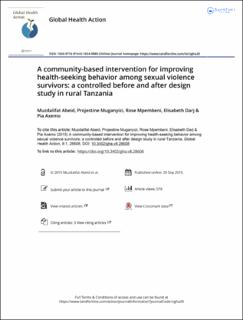| dc.contributor.author | Abeid, Muzidalifat | |
| dc.contributor.author | Muganyizi, Projestine | |
| dc.contributor.author | Mpembeni, Rose | |
| dc.contributor.author | Darj, Elisabeth | |
| dc.contributor.author | Axemo, Pia | |
| dc.date.accessioned | 2020-06-23T12:20:27Z | |
| dc.date.available | 2020-06-23T12:20:27Z | |
| dc.date.created | 2015-10-29T18:15:51Z | |
| dc.date.issued | 2015 | |
| dc.identifier.citation | Global health action. 2015, 8 . | en_US |
| dc.identifier.issn | 1654-9716 | |
| dc.identifier.uri | https://hdl.handle.net/11250/2659174 | |
| dc.description.abstract | Background: Despite global recognition that sexual violence is a violation of human rights, evidence stillshows it is a pervasive problem across all societies. Promising community intervention studies in the low- andmiddle-income countries are limited.Objective: This study assessed the impact of a community-based intervention, focusing on improving thecommunity’s knowledge and reducing social acceptability of violence against women norms with the goal toprevent and respond to sexual violence.Design: The strategies used to create awareness included radio programs, information, education communica-tion materials, and advocacy meetings with local leaders. The intervention took place in Morogoro region inTanzania. The evaluation used a quasi-experimental design including cross-sectional surveys at baseline (2012)and endline (2014) with men and women aged 18 49 years. Main outcome measures were number of reportedrape cases at health facilities and the community’s knowledge and attitudes toward sexual violence.Results: The number of reported rape events increased by more than 50% at health facilities during theintervention. Knowledge on sexual violence increased significantly in both areas over the study period (from57.3 to 80.6% in the intervention area and from 55.5 to 71.9% in the comparison area;pB0.001), and the neteffect of the intervention between the two areas was statistically significant (6.9, 95% CI 0.2 13.5,p 0.03).There was significant improvement in most of the attitude indicators in the intervention area, but not in thecomparison area. However, the intervention had no significant effect on the overall scores of acceptanceattitudes in the final assessment when comparing the two areas ( 2.4, 95% CI: 8.4 to 3.6,p 0.42).Conclusions: The intervention had an effect on some indicators on knowledge and attitudes toward sexualviolence even after a short period of intervention. This finding informs the public health practitioners of theimportance of combined strategies in achieving changes. | en_US |
| dc.language.iso | eng | en_US |
| dc.publisher | Taylor & Francis Open | en_US |
| dc.rights | Navngivelse 4.0 Internasjonal | * |
| dc.rights.uri | http://creativecommons.org/licenses/by/4.0/deed.no | * |
| dc.title | A community-based intervention for improving health-seeking behavior among sexual violence survivors: a controlled before and after design study in rural Tanzania | en_US |
| dc.type | Peer reviewed | en_US |
| dc.type | Journal article | en_US |
| dc.description.version | publishedVersion | en_US |
| dc.source.pagenumber | 9 | en_US |
| dc.source.volume | 8 | en_US |
| dc.source.journal | Global health action | en_US |
| dc.identifier.doi | 10.3402/gha.v8.28608 | |
| dc.identifier.cristin | 1284714 | |
| dc.description.localcode | © 2015 Muzdalifat Abeid et al. This is an Open Access article distributed under the terms of the Creative Commons Attribution 4.0International License (http://creativecommons.org/licenses/by/4.0/), allowing third parties to copy and redistribute the material in any medium or format and toremix, transform, and build upon the material for any purpose, even commercially, provided the original work is properly cited and states its license | en_US |
| cristin.ispublished | true | |
| cristin.fulltext | original | |
| cristin.qualitycode | 1 | |

